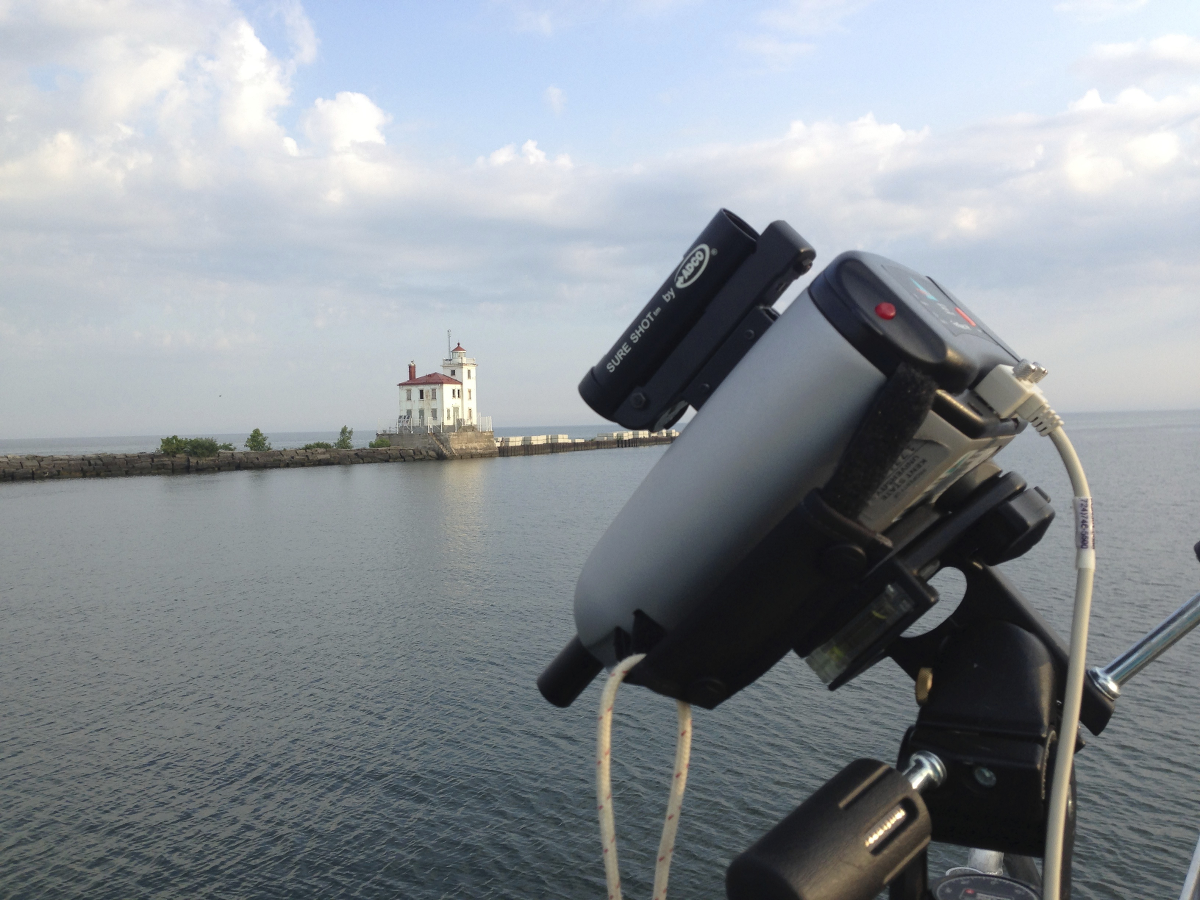
Heading out on Lake Erie to measure surface reflectance with one of my spectroradiometers.
Nutrients provides the raw materials needed to fuel algal blooms, the rapid growth of single-celled algae in lakes or the ocean. Increasing nutrients and water temperature can also alter the ecology of aquatic systems, creating conditions that favor Harmful Algal Blooms (HABs) by algae capable of producing toxins. Lake Erie and other bodies of water in Ohio and around the world are experiencing increasing numbers of HAB-related problems. Blooms of these nuisance species can result in a number of environmental problems such as illness, foul odors and bad taste. When the algae die, they sink to the bottom and decompose. The result is a drop in oxygen in bottom waters called hypoxia or if no oxygen remains, anoxia. That can release trace metals into the water or make the water more corrosive. I use remote sensing to study the distribution and composition of algae to monitor and predict HABs.
Work in my lab focuses on using visible and near infrared energy to discover how algal blooms affect water color. Using multivariate statistics, we can identify different types of algae based on how they alter water color. This work can be done using remote sensing data, in the field with handheld sensors, or in the lab using filtered water samples.
Collaborators
- Dr. George Bullerjahn, Biological Sciences, BGSU
- Dr. Jen Mou, Department of Biological Sciences, Kent State University
- Dr. Adem Ali, Department of Geology and Environmental Science, College of Charleston
- NASA Glenn Research Center
- USGS Lake Erie Biological Station
- OhioView Consortium Researchers
Funding Agencies
- NASA
- Ohio Department of Higher Education
- Ohio Sea Grant Program
This Research in the News
An article about my work was recently featured in the Environmental Monitor the online trade journal for Fondriest Environmental, which sells and services scientific instrumentation for environmental monitoring. My work has also been showcased in the Twineline, the Ohio Sea Grant’s journal, and as part of a panel discussion on water quality technologies in Ohio on NPR’s “The Sound of Ideas”.
WKYC TV aired a piece regarding my role in the NASA monitoring program that responded to the 2014 Lake Erie HAB that shut down the water supply in Toledo, leaving almost 500,000 Ohioans without water for a full weekend. Articles from Kent State sources regarding my research have appeared on the Division of Research and Sponsored Programs website (“Lake Erie’s Algae Monitored from Space“) and in the Kent State Magazine (“Toxic Threat“).
Recent Publications
Application of Aqua MODIS sensor data for estimating chlorophyll a in the turbid Case 2 waters of Lake Erie using bio-optical models KA Ali, JD Ortiz, N Bonini, M Shuman, C Sydow, GIScience & Remote Sensing
Global solutions to regional problems: Collecting global expertise to address the problem of harmful cyanobacterial blooms. A Lake Erie case study GS Bullerjahn, RM McKay, TW Davis, DB Baker, GL Boyer, LV D’Anglada, … JD Ortiz …, Harmful Algae
Multivariate approach for chlorophyll-a and suspended matter retrievals in Case II waters using hyperspectral data, KA Ali and JD Ortiz, Hydrological Sciences Journal.
Evaluating multiple color producing agents in Case II waters from Lake Erie, JD Ortiz, DL Witter, KA Ali, N Fela, M Duff and L Mills, L., Journal of Remote Sensing, 34 (24), 8854-8880.
Diversity and distribution of free-living and particle associated bacterioplankton in Sandusky Bay and adjacent waters of Lake Erie Western Basin, X Mou, J Jacob, X Lu, S Robbins, S Sun and JD Ortiz, Journal of Great Lakes Research.
Application of empirical and semi-analytical algorithms to MERIS data for estimating chlorophyll a in Case waters of Lake Erie, KA Ali, DL Witter and JD Ortiz, Environmental Earth Sciences.
Multivariate approach to estimate color producing agents in Case 2 waters using first-derivative spectrophotometer data, KA Ali, DL Witter and JD Ortiz, Geocarto International.
Assessing the Application of SeaWiFS Ocean Color Algorithms to Lake Erie, D Witter, J Ortiz, S Palm, R Heath and J Budd, Journal of Great Lakes Research, 35, 361-370.
